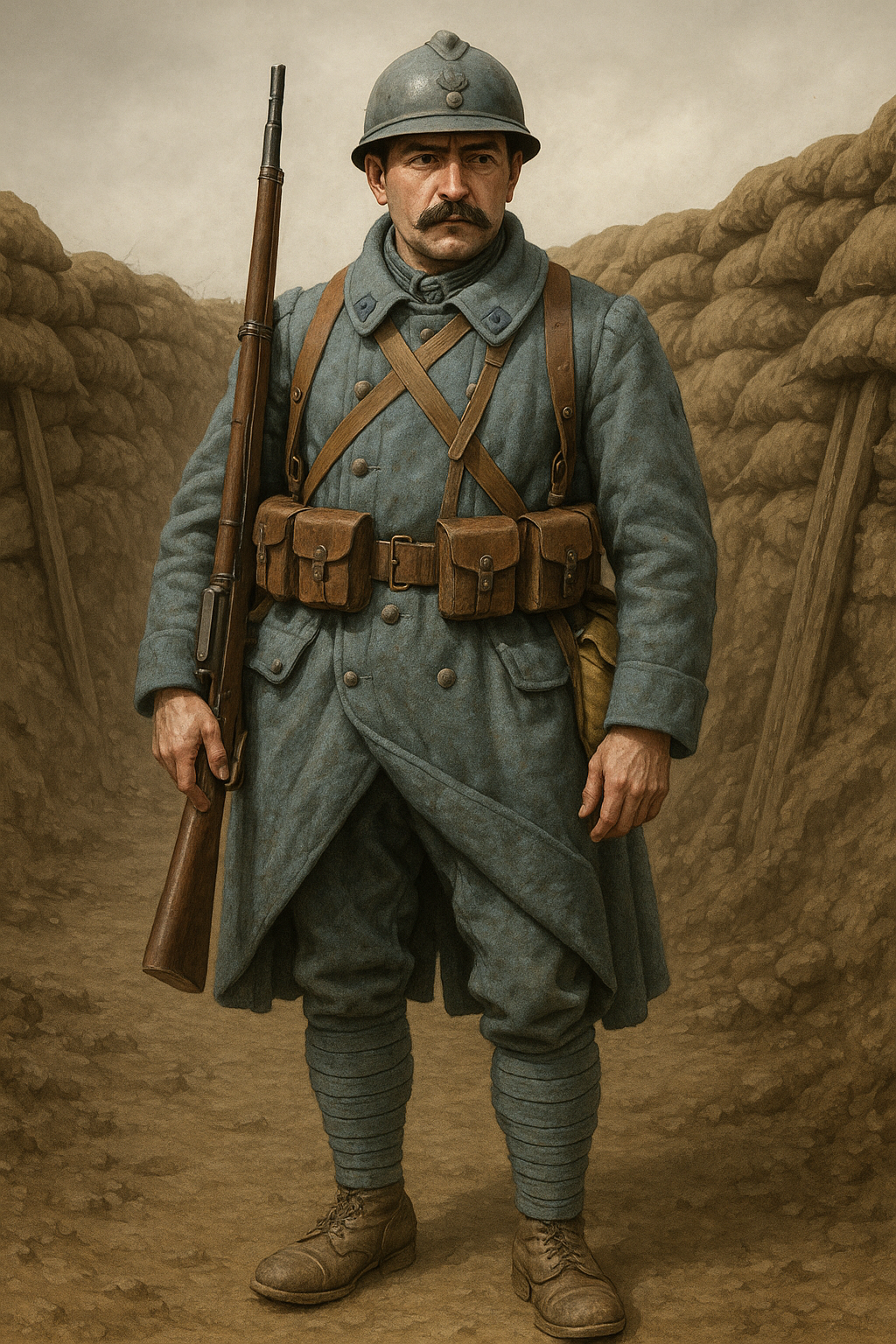
What Did French Soldiers Wear in WW1? A Complete Look at the French WW1 Uniform
Published on Jun 26, 2025
Inside the French World War 1 Uniform: History, Design & Legacy
World War I changed not just the map of Europe but also how war was fought—and seen. One of the most precise visual shifts was in military uniforms. France, a country steeped in military tradition, entered the Great War with bold red trousers and left it with subdued, functional gear. The French World War 1 uniform tells a story of battlefield adaptation, national pride, and cultural legacy. Let’s look at what French soldiers wore on the Western Front.
1. A Colorful Start: The 1914 French Uniform
At the outbreak of the war, the French Army’s standard attire was rooted in 19th-century style. The infantryman—called the Poilu, meaning “hairy one” as a nod to rugged masculinity—marched into battle wearing a uniform that looked more suited for parades than trenches.
Standard 1914 Uniform Included:
- Red trousers (pantaloon rouge): Bright and eye-catching
- Dark blue wool tunic: Military cut with brass buttons
- Kepi cap: A tall, round hat with a flat top and short visor
- Black leather boots and belt
While visually striking, this uniform proved fatal in the face of modern warfare. French soldiers stood out to enemy sharpshooters, and casualties soared in the early months.
2. A Drastic Shift: The Birth of Horizon Blue
In response to heavy losses and public outcry, WW1 French Army revamped its look. The result was a more practical and camouflaged uniform, the horizon blue uniform, introduced in 1915.
Why “Horizon Blue”?
The soft blue-grey color blended better with trench warfare's smoky, muddy conditions. It was meant to mimic the horizon line — subtle, not flashy.
Key Components:
- Capote modèle 1915: A long wool coat, double-breasted with large collars
- Pants and puttees: Baggy wool trousers and leg wraps
- Adrian helmet: Steel helmet designed to protect against shrapnel
- Canvas gear: Ammo pouches, gas mask containers, haversacks
This new look marked a turning point in French military outfitting, focusing on survivability and utility over style.
3. The Iconic Adrian Helmet
One of the most enduring symbols of the French WW1 soldier is the Adrian helmet, introduced in 1915. Named after its designer, General August-Louis Adrian, it was one of the first modern steel helmets adopted by any army during WW1.
Helmet Features:
- Crest ridge to deflect shrapnel
- Lightweight yet strong
- It is painted in horizon blue to match the uniform
The helmet became so iconic that other nations, including Belgium and Italy, later adopted variations of the Adrian design.
4. Accessories and Trench Essentials
Life in the trenches required French soldiers to wear more than a standard uniform. They carried a range of essential items for survival and combat readiness.
Common Accessories:
- Gas masks: Crucial after Germany introduced poison gas
- Entrenching tools: Small spades for digging trenches or shelters
- Mess kits and canteens: For food and water
- Ammo pouches and bandoliers
- Greatcoat: Extra warmth in freezing trench conditions
Many soldiers personalized their gear, adding patches, photos, and mementos from home, offering a human touch to an otherwise harsh environment.
5. Ranks, Regiments & Customizations
The French Army used a detailed insignia system to identify rank, unit, and service branch.
Uniform Customization Examples:
- Collar tabs: Color-coded to show regiment (e.g., red for artillery, yellow for cavalry)
- Sleeve chevrons: Marked years of service or wounds
- Badges and medals: Indicated bravery or memorable roles (e.g., machine gunner)
Officers wore tailored versions of the uniform, often better cut and sometimes privately purchased for comfort.
6. Women’s Uniform Roles During WW1
While not front-line fighters, women in France played essential wartime roles—from nursing to factory work. The Red Cross and other support groups provided uniforms to nurses and volunteers, typically consisting of:
- Practical tunics and skirts or trousers
- Aprons, gloves, and medical insignia
- Headscarves or caps to identify roles
These women’s uniforms were designed for function and dignity, offering them a visible place in the war effort.
7. Collecting French WW1 Uniforms Today
For historians and collectors, French WW1 uniforms are highly valued due to their distinctive style and evolution. Original items are sought after at military fairs, auctions, and online marketplaces.
Collector Tips:
- Beware of replicas: Modern reproductions often use synthetic materials and incorrect stitching.
- Check for markings: Authentic uniforms may include maker stamps or regimental tags.
- Condition is key: Intact buttons, original dyes, and minimal moth damage can greatly enhance value.
At Paddelaters.com, we specialize in sourcing authentic and replica WW1 French military attire for collectors and reenactors.
Conclusion: A Uniform That Tells a Story
The French World War 1 uniform is much more than just military attire. It’s a visual record of how France and warfare transformed over four brutal years. From the bold red trousers of 1914 to the somber, functional horizon blue of 1915 and beyond, every change in fabric, color, and cut reflects a shift in strategy, technology, and the human experience of war.
The uniform was their identity, protection, and home link for soldiers in the trenches. For us today, it's a window into history—a reminder of courage, sacrifice, and innovation born from necessity.
Whether you’re a collector, a reenactor, a history enthusiast, or simply curious, the legacy of the French WWI uniform is worth preserving. At Paddelaters, we honor that legacy by offering quality pieces that bring the past back to life—one stitch at a time.
